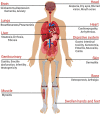Human arginase I: a potential broad-spectrum anti-cancer agent
- PMID: 37152001
- PMCID: PMC10156892
- DOI: 10.1007/s13205-023-03590-3
Human arginase I: a potential broad-spectrum anti-cancer agent
Abstract
With high rates of morbidity and mortality, cancer continues to pose a serious threat to public health on a global scale. Considering the discrepancies in metabolism between cancer and normal cells, metabolism-based anti-cancer biopharmaceuticals are gaining importance. Normal cells can synthesize arginine, but they can also take up extracellular arginine, making it a semi-essential amino acid. Arginine auxotrophy occurs when a cancer cell has abnormalities in the enzymes involved in arginine metabolism and relies primarily on extracellular arginine to support its biological functions. Taking advantage of arginine auxotrophy in cancer cells, arginine deprivation, which can be induced by introducing recombinant human arginase I (rhArg I), is being developed as a broad-spectrum anti-cancer therapy. This has led to the development of various rhArg I variants, which have shown remarkable anti-cancer activity. This article discusses the importance of arginine auxotrophy in cancer and different arginine-hydrolyzing enzymes that are in various stages of clinical development and reviews the need for a novel rhArg I that mitigates the limitations of the existing therapies. Further, we have also analyzed the necessity as well as the significance of using rhArg I to treat various arginine-auxotrophic cancers while considering the importance of their genetic profiles, particularly urea cycle enzymes.
Keywords: Arginase I; Auxotrophy; Cancer; Fusion technology; PEGylation.
© King Abdulaziz City for Science and Technology 2023, Springer Nature or its licensor (e.g. a society or other partner) holds exclusive rights to this article under a publishing agreement with the author(s) or other rightsholder(s); author self-archiving of the accepted manuscript version of this article is solely governed by the terms of such publishing agreement and applicable law.
Conflict of interest statement
Conflict of interestThe authors declare that they have no conflict of interest.
Figures



References
-
- A Phase I open-label study for subjects with advanced malignancies (PT01). ClinicalTrials.gov Identifier: NCT04136834. https://clinicaltrials.gov/
-
- ADI-PEG 20 in combination with gemcitabine and docetaxel for the treatment of soft tissue sarcoma, osteosarcoma, Ewing’s sarcoma, and small cell lung cancer. ClinicalTrials.gov Identifier: NCT03449901. https://clinicaltrials.gov/
-
- Aeglea-enzymes for rare metabolic diseases-Pegzilarginase. https://www.aeglea.com/pegzilarginase/. Accessed 2 Sep 2022
-
- Allen MD, Luong P, Hudson C, Leyton J, Delage B, Ghazaly E, Cutts R, Yuan M, Syed N, Lo Nigro C, Lattanzio L, Chmielewska-Kassassir M, Tomlinson I, Roylance R, Whitaker HC, Warren AY, Neal D, Frezza C, Beltran L, Jones LJ, Chelala C, Wu BW, Bomalaski JS, Jackson RC, Lu YJ, Crook T, Lemoine NR, Mather S, Foster J, Sosabowski J, Avril N, Li CF, Szlosarek PW. Prognostic and therapeutic impact of argininosuccinate synthetase 1 control in bladder cancer as monitored longitudinally by PET imaging. Cancer Res. 2014;74(3):896–907. doi: 10.1158/0008-5472.can-13-1702. - DOI - PubMed
Publication types
LinkOut - more resources
Full Text Sources

